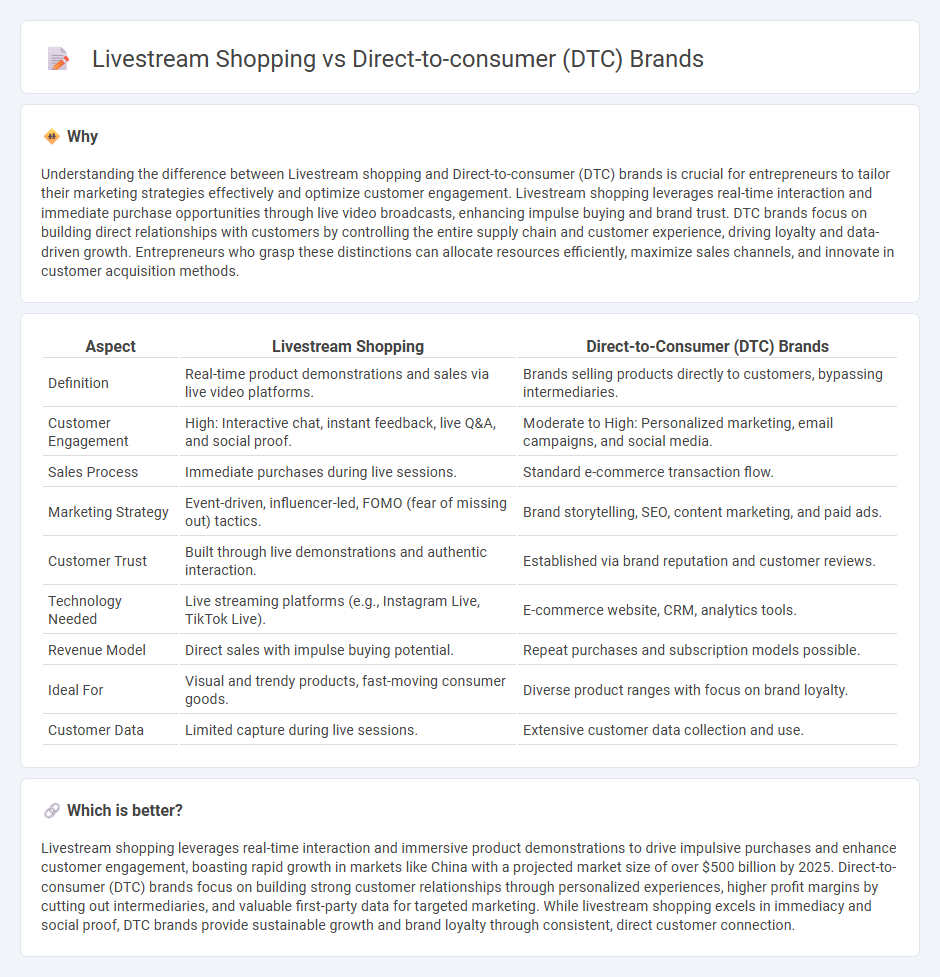
Livestream shopping revolutionizes consumer engagement by combining real-time interactivity and instant purchasing, creating immersive brand experiences that drive impulse buys and foster loyalty. Direct-to-consumer (DTC) brands leverage personalized marketing and seamless online platforms to build strong customer relationships and optimize profit margins without intermediaries. Explore the dynamic strategies shaping modern entrepreneurship to understand how these models transform retail growth.
Why it is important
Understanding the difference between Livestream shopping and Direct-to-consumer (DTC) brands is crucial for entrepreneurs to tailor their marketing strategies effectively and optimize customer engagement. Livestream shopping leverages real-time interaction and immediate purchase opportunities through live video broadcasts, enhancing impulse buying and brand trust. DTC brands focus on building direct relationships with customers by controlling the entire supply chain and customer experience, driving loyalty and data-driven growth. Entrepreneurs who grasp these distinctions can allocate resources efficiently, maximize sales channels, and innovate in customer acquisition methods.
Comparison Table
| Aspect | Livestream Shopping | Direct-to-Consumer (DTC) Brands |
|---|---|---|
| Definition | Real-time product demonstrations and sales via live video platforms. | Brands selling products directly to customers, bypassing intermediaries. |
| Customer Engagement | High: Interactive chat, instant feedback, live Q&A, and social proof. | Moderate to High: Personalized marketing, email campaigns, and social media. |
| Sales Process | Immediate purchases during live sessions. | Standard e-commerce transaction flow. |
| Marketing Strategy | Event-driven, influencer-led, FOMO (fear of missing out) tactics. | Brand storytelling, SEO, content marketing, and paid ads. |
| Customer Trust | Built through live demonstrations and authentic interaction. | Established via brand reputation and customer reviews. |
| Technology Needed | Live streaming platforms (e.g., Instagram Live, TikTok Live). | E-commerce website, CRM, analytics tools. |
| Revenue Model | Direct sales with impulse buying potential. | Repeat purchases and subscription models possible. |
| Ideal For | Visual and trendy products, fast-moving consumer goods. | Diverse product ranges with focus on brand loyalty. |
| Customer Data | Limited capture during live sessions. | Extensive customer data collection and use. |
Which is better?
Livestream shopping leverages real-time interaction and immersive product demonstrations to drive impulsive purchases and enhance customer engagement, boasting rapid growth in markets like China with a projected market size of over $500 billion by 2025. Direct-to-consumer (DTC) brands focus on building strong customer relationships through personalized experiences, higher profit margins by cutting out intermediaries, and valuable first-party data for targeted marketing. While livestream shopping excels in immediacy and social proof, DTC brands provide sustainable growth and brand loyalty through consistent, direct customer connection.
Connection
Livestream shopping revolutionizes the direct-to-consumer (DTC) brand model by enabling real-time interaction and personalized customer experiences, boosting engagement and conversion rates. DTC brands leverage livestream platforms to showcase products authentically, reduce reliance on traditional retail channels, and gather immediate consumer feedback. This synergy enhances brand loyalty, accelerates sales cycles, and drives higher profit margins through direct customer relationships.
Key Terms
Customer acquisition
Direct-to-consumer (DTC) brands leverage personalized marketing strategies and direct engagement channels to enhance customer acquisition, reducing reliance on intermediaries. Livestream shopping harnesses real-time interaction and immersive experiences to boost conversion rates and cultivate brand loyalty through instant feedback and social proof. Explore how integrating these approaches can optimize customer acquisition efficiency and growth potential.
Real-time engagement
Direct-to-consumer (DTC) brands leverage personalized online platforms to build strong customer loyalty and gather valuable data insights. Livestream shopping transforms real-time engagement by combining entertainment with instant purchasing, enhancing customer interaction and driving immediate conversions through interactive video content. Explore how these innovative strategies reshape consumer experiences and boost brand growth.
Conversion rate
Direct-to-consumer (DTC) brands typically see an average conversion rate of 1-3%, while livestream shopping can boost conversion rates to as high as 30% due to real-time engagement and instant purchasing options. Livestream shopping leverages interactive video content and influencer partnerships to create a sense of urgency and trust, directly impacting sales performance. Explore in-depth comparisons and strategies to optimize conversion rates in both DTC and livestream shopping channels.
Source and External Links
Top 35 DTC Brands to Keep an Eye on in 2025 - Describes several notable direct-to-consumer (DTC) brands like Three Ships, The Farmer's Dog, LOLA, and Feastables, highlighting how these companies sell directly to consumers while building strong brand communities and offering subscription models.
40 Direct-to-Consumer Brands To Explore (2025) - Explains DTC brands such as Casper, Glossier, Away, and Everlane, emphasizing features like cutting out intermediaries for competitive pricing, community-driven marketing, and ethical transparency as key differentiators in the DTC model.
Direct to Consumer (DTC) Definition - Glossary - Defines DTC as a sales strategy where brands sell products directly to customers online, bypassing retailers and wholesalers, with examples including Away, Glossier, Warby Parker, and Bombas, noting the growth driven by ecommerce and changing consumer habits.
 dowidth.com
dowidth.com